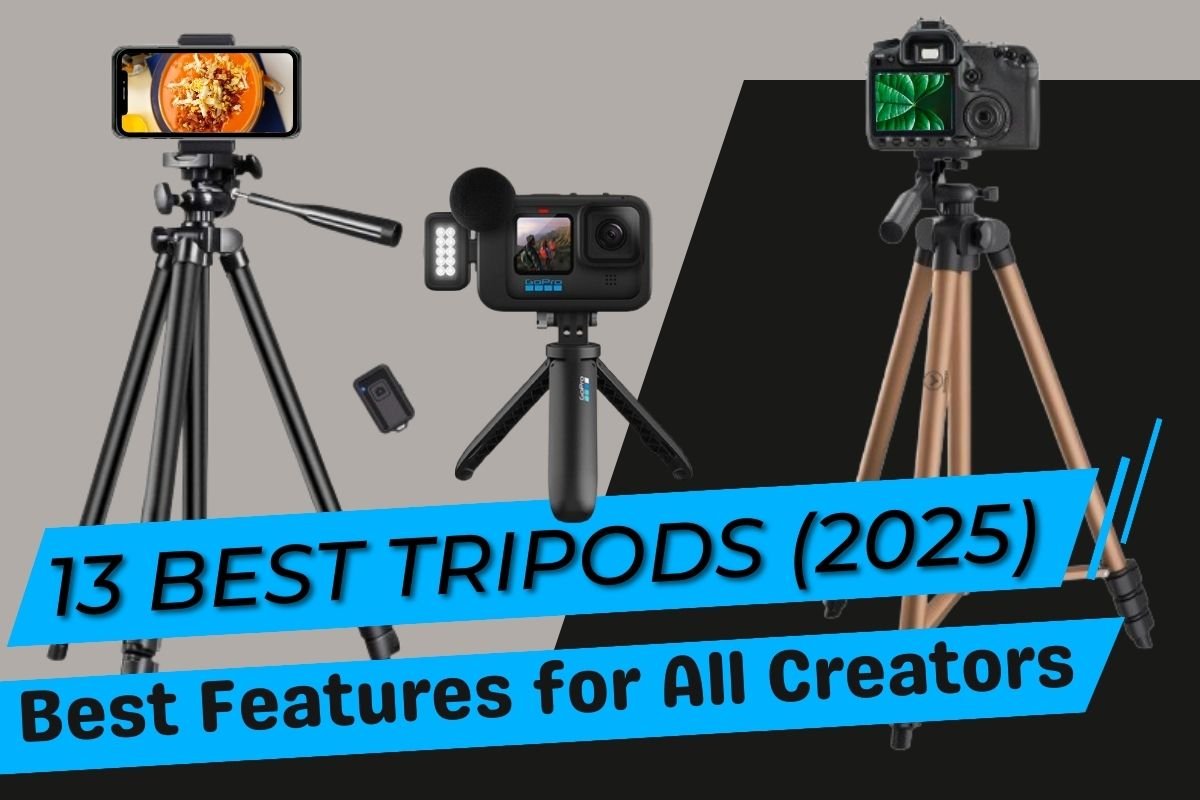It’s common knowledge that the best tripod should aid a content creator’s work by offering an extraordinarily stable and good-looking shot. So whether you’re shooting videos, glamorous landscapes, or vlogs, this stabilizing tool will make your work look straighter and more professional. With 2025 approaching, innumerable tripod varieties are available, boasting Bluetooth remotes, lightweight designs, and height adjustment options. These meet the unique needs of photographers, videographers, and vloggers.
This review will discuss the 13 Best Tripods in 2025 with Best Features for All Creators, listing their features, benefits, and drawbacks, and explaining how they match your needs for traveling, vlogging, or other lightweight tripod requirements using Bluetooth remote capability. This is like a short guide on choosing the right tripod for your shooting style and needs, which can hopefully clear up any decision-making headaches as you create your content.
Table of Contents
Things to Keep in Mind When Looking for the Best Tripod: Buying Guide
A quality tripod will be your best choice depending on the type of content you create and the devices you use. Tripods have a major effect on the quality of your photography and videography. Awesome visuals are reachable when the user gets involved in a creative life. Consider the following major factors when choosing the best tripod.
1. Content-Type:
Which type of content you will be producing is the factor you should consider first when you are selecting the best tripod. Let’s suppose you are in search of a tripod for vlogging.
2. Tripod Flexibility:
Consider that a tripod that can be used for both a camera and a mobile device will enable you to switch back and forth between the two devices easily without compromising the stability and/or the quality of your footage. Most of the latest tripods for cameras and mobiles come with adaptable mounts and/or attachments that are compatible with both types of cameras – smartphones and DSLRs, and mirrorless ones alike.
3. Tripod Stability:
Before even thinking of testing your equipment’s productivity with your tripod, expect it to be stable under all conditions. Higher models might do better in wind, whereas shorter ones could be sturdier. Getting the best tripod with a long service life and superior leg-locking systems is the way to go for razor-sharp images.
4. Tripod Weight and Portability:
If your work often involves moving from one place to another, this should be the option to go for. Moreover, if you are the kind of person who prefers to concentrate on a single location, then a bulkier and more durable tripod can also be the most appropriate option due to its better support and stability.
Modern travel tripods are designed to collapse to a compact size. This feature is very convenient as whenever you go hiking or camping, you can easily fit these tripods in your backpack, or if it’s a camera tripod, it’s small enough to fit into the camera bag. The materials used in the design of these tripods, such as carbon fiber, provide a combination of lightness and a strong frame, which has made them a favorite choice among enthusiastic photographers.
5. Tripod Build Quality:
One of the factors affecting the life expectancy of a tripod is the build quality and the material used. They are one of the crucially important features that define the lasting endurance of the tripod and its general performance. Tripods made with carbon fiber are lightweight and durable, while tripods made with aluminium are heavier but lower cost. Before purchasing, think about the type of materials used to make the tripod.
6. Built-in Features:
Other built-in features of a tripod, like height adjustment, quick-release plates, remote functionality, and a durable leg lock mechanism, help you choose the right one for various uses.
6.1. Tripod Head:
In case you are switching between different shooting styles or angles on a regular basis, you may also want to check out tripods with ball heads or fluid heads for easily adjusting them.
6.2. Tripod Leg Lock Mechanisms:
The different leg lock systems (twisting or flipping locks) refer to the difference in convenience and speed when setting up your tripod. Moreover, it is worth mentioning that you can try different varieties of them to find one that suits you the most.
6.3. Tripod with Bluetooth Remote:
Get a selfie stick or tripod with Bluetooth remotes to help control your phone and camera. If you are alone, you can take photos from a distance using the Bluetooth remote by keeping the camera still to avoid blurry images.
6.4. Tripod with Built-in Ring Light:
You should give a tripod with ring light priority over others, as it not only improves your video quality and makes your face glow with flattering illumination, but also sets you apart from the crowd. The embedded ring light in the tripod will allow you to keep the light levels constant, which is important in creating content that looks professional and polished. With this tool, users can deal with environments that are either too dark or require better presentation for video calls or social media to be more engaging.
Looking for the highest quality tripods? Bear in mind a variety of factors guaranteeing you get the correct one for your photos and videos. A good tripod is not only reliable but can also make your shooting process more perfect, so imagine you’re taking pics of picturesque nature views, filming vlogs, or enjoying taking selfies with your friends.
How to Choose the Best Tripod Head?
To take amazing photos, you need the right gear, and the best tripod is the key. But don’t forget about the tripod head – it’s just as important.
There are generally three types of tripod heads: ball heads, pan-tilt heads, and fluid heads, and each serves a specific function, allowing photographers to achieve a variety of angles and perspectives.
1. Ball Head:
Photographers love ball heads because of their versatility and quick adjustment. You can move them in any direction quickly, which is great if you need flexibility to change your shot fast.

2. Pan-tilt Head:
If you want more control, go for a pan-tilt head. These are perfect for taking precise shots if you’re into landscape or architectural photography.
3. Fluid Head:
Fluid head tripods basically used for videography. Fluid head offers smooth panning and super tilting, so you can get those movie-like shots without any shaking that you might see with other heads.
Some new tripods come with cool extras like Bluetooth remote controls. These are handy if you want an all-in-one solution.
The top tripods with Bluetooth remotes let you use your camera from far away, which is great for capturing unexpected moments. You can often change the settings on these tripods too, so it’s easy to try out different ways of shooting while keeping your camera steady.
The right tripod head can elevate your photography experience to new heights. Consider the type of photography you pursue and additional features that can enhance your shooting experience when choosing a tripod head.
What are the features of the best tripod legs?
The tripod legs are one of the important components that significantly affect stability and usability. Here are some key factors of a tripod head to consider when choosing the best one.
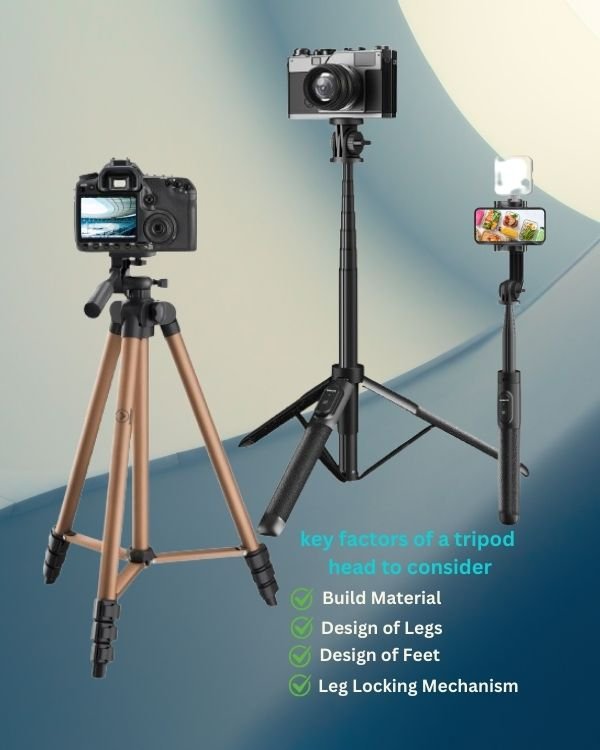
1. Build Material:
Tripod legs come in different materials like aluminium, carbon fiber, and plastic. Each material has its own pros when it comes to weight, durability, and price. People who travel or hike frequently find carbon fiber just right. It strikes a good balance between being strong and easy to carry around.
2. Design of Legs:
Tripods have legs that you can make longer or shorter. This lets you change the height to fit different photo angles and settings. How easy it is to make the legs longer, whether by twisting or flipping a lock, can affect how fast a photographer can set up when things are moving.
It helps photographers get creative shots without having to bend down or look for a different spot to shoot from. Some tripods can get really tall or short. This lets users take photos from very low or high up, catching some cool views.
3. Design of Feet:
People often forget about tripod feet, but they’re key to staying steady on all kinds of ground. Some tripods have rubber feet that grip smooth surfaces well. Others might have spiked feet that work better on bumpy ground.
Depending on your photography style and the location where you shoot, choosing a tripod with interchangeable feet can make your setup more flexible. This lets you switch between indoor studio shots and outdoor landscape work.
Standard Features and Specifications for the Best Tripod
Consider the following lists of standard features and specifications when choosing the best tripod for all creators and photographers.
Build Material and Design
| Build Material: | Lightweight and sturdy materials (carbon fiber or aluminum for portability and durability). |
| Weight Capacity: | Minimum 5 kg (11 lbs) to support a variety of cameras, from smartphones to DSLRs and mirrorless cameras, and accessories. |
| Folded Length: | Max 50 cm (20 inches) for portability and easy storage. |
| Leg Sections: | 3-5 sections with secure twist or flip locks |
Stability & Adjustability
| Maximum Height: | At least 150 cm (59 inches) for eye-level shooting |
| Minimum Height: | Below 40 cm (16 inches) for low-angle or macro shots |
| Leg Locking Mechanism: | Secure and quick operation (twist or flip locks) |
| Centre Column: | Adjustable or reversible for macro photography |
| Feet Design: | Rubber feet with optional spikes for all ground conditions |
Head and Mounting Options
| Head Type: | Ball Head or Pan-Tilt Head for Smooth movement and precise adjustments |
| Quick Release Plate: | Arca-Swiss compatible for universal mounting for various gear for easy and fast camera mounting and removal |
| Angle and Rotation: | 360° Rotation Essential for panoramas and cinematic video work |
Best Tabletop Tripods
When it comes to photography and videography, tabletop tripods are especially useful for shooting in confined spaces or at specific angles. Let’s take a look at some of the great features to consider when deciding which tabletop tripod is best for your needs:
- 1. Availability of Bluetooth remote.
- 2. Height-adjustable feature.
- 3. Lightweight, portable, and strong.
- 4. Stability.
Join the 3-Step High-Ticket Affiliate Marketing Course to increase your affiliate commission up to 60% per shell.
13 Best Tripod Deals (2025)
SIRUI Carbon Fiber Travel Tripod
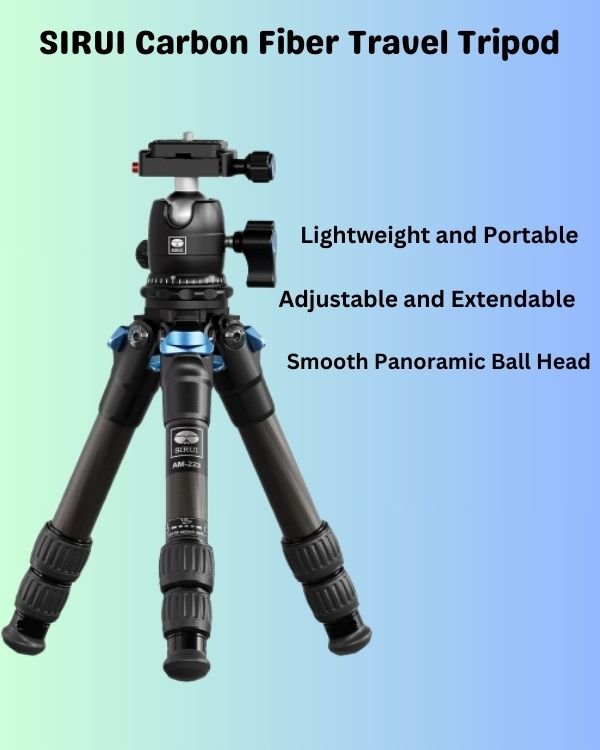
Features :
- Built Material: Carbon fiber
- Adjustable Height: 13cm to 43cm
- Max Load: 33.1 lbs
- Head: 360o rotation Ball head
- Leg Sections : 3
- Rubber feet and metal spikes
Pros: Portable and Extremely Lightweight, Adjustable Height and Twist-Lock System, Compatible with Phone and Camera.
Cons: Expensive for Casual Creators.
Suitable for: Travel Photographers, Landscape Photographers
Manfrotto MT055XPRO3 055 Aluminium Tripod

Features :
- Built Material: Aluminium
- Adjustable Height: 40cm to 151cm
- Max Load: 19.84 lbs
- Head: 360o rotation Ball head
- Leg Sections : 3
- Quick Power Lock (QPL)
Pros: Sturdy and Stable, Quick Release Mechanism, Adjustable Ball Head, Quick Power Lock for Stability, Compatible with Phone and Camera.
Cons: A Little heavy compared to a travel tripod.
Suitable for: Vloggers, Content creators- useful for professional work
UBeesize 51” Tripod with Bluetooth Remote
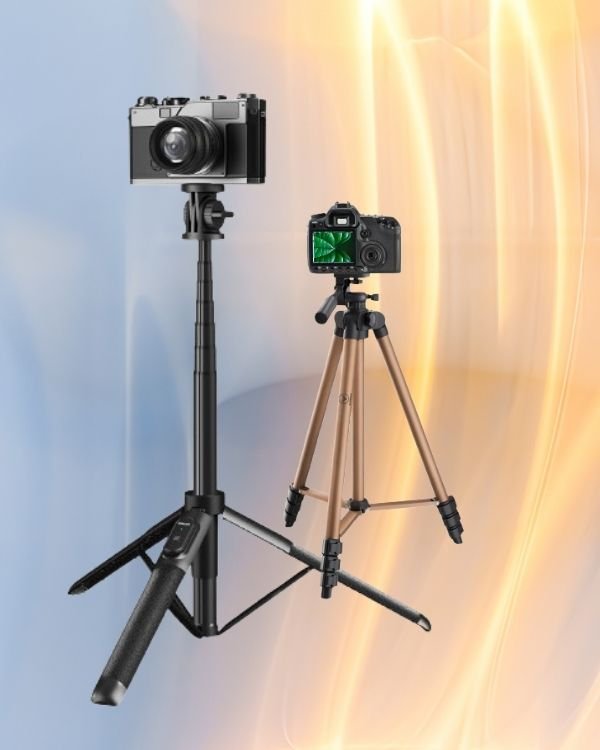
Features :
- Built Material: Aluminium
- Adjustable Height: 17 inches to 62 inches
- Head: Pan Heads
- Leg Sections : 3
- Bluetooth Remote
Pros: Lightweight design, Wireless Remote for Hands-Free Operation, Wide Compatibility with Various types of Cell Phone, Adjustable Heights, Budget Tripod.
Cons: The Maximum load capacity is low.
Suitable for: Best for mobile Vloggers and Content Creators.
Amazon Basics 60-inch Professional Tripod

Features :
- Built Material: Aluminium
- Adjustable Height: 53cm to 151.1cm
- Max Load: 5 kg
- Head: 360o rotation Ball head
- Leg Sections : 3
Pros: Lightweight design, Wide Compatibility with Cell Phone and Camera, Adjustable Heights, Budget Tripod, Non-Slip Rubber Feet.
Cons: The Maximum load capacity is low.
Suitable for: Best for Beginners, Vloggers, and Casual Photographers.
DIGITEK DTR 550 LW 67 Inch Foldable Tripod

Features :
- Built Material: Aluminium
- Adjustable Height: Maximum height of 67 inches
- Max Load: 5 kg
- Head: 360o rotation Ball head
- Leg Sections : 3
Pros: Lightweight and portable, Better Stability with Flip Locks and Rubberized Feet, Compatibility with Phone and Camera, Easily Foldable, Includes Carrying Bag.
Cons: The Maximum load capacity is low.
Suitable for: Best for Beginners, Vloggers, and Amateur Photographers.
Neewer Carbon Fiber 66 inches Camera Tripod
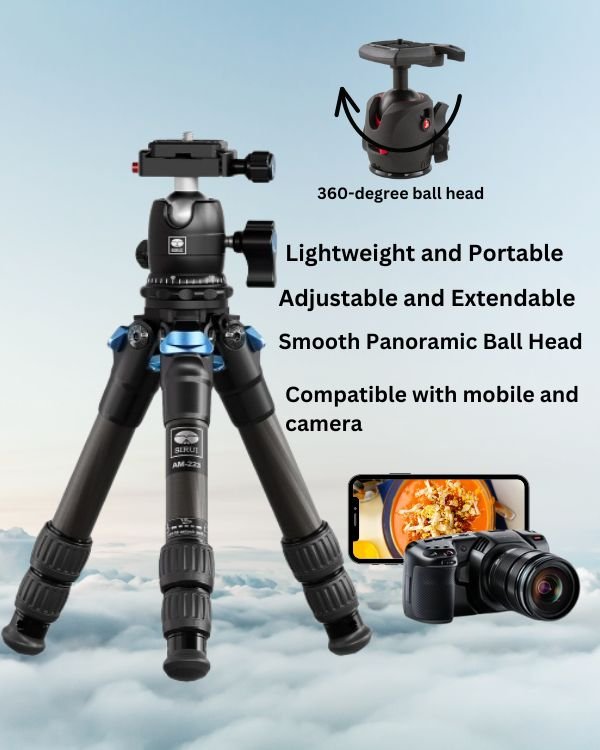
Features :
- Built Material: Carbon fiber
- Adjustable Height: 47cm to 172cm
- Max Load: 12 kg
- Head: 360o rotation Ball head
- Leg Sections : 3
Pros: 2 in 1 Lightweight Tripod and Monopod, Quick Release Leg Locking, Compatibility with DSLR Cameras, Easily Foldable, Includes Carry bag and Essential Accessories kit.
Cons: Can be bulky for travel.
Suitable for: Best for Vlogging, Photography, and Videography.
DIGITEK DTR 520 BH 152CM Tripod Cum Monopod

Features :
- Built Material: Aluminium
- Adjustable Height: Max operating height: 4.95 ft
- Max Load: 7kg Max Load
- Head: Pan Head
- Leg Sections : 3
Pros: 2 in 1 Lightweight Tripod and Monopod, Multipurpose Head for Low Level Shooting, Compatibility with DSLR Cameras and Camcorders, Easily Foldable.
Cons: Mobile holder not included.
Suitable for: Best for Professional Photography and Videography.
Syvo S-3520A 60 Inch Tripod

Features :
- Built Material: Aluminium
- Adjustable Height: 21.46 Inches to 60 Inches
- Max Load: 5kg Max Load
- Head: 360 Degree Ball Head
- Leg Sections : 3
Pros: Lightweight, Quick Height Adjustable Features, Highly Compatible with various Digital Cameras, Still Cameras, GoPro devices, and Mobile Phones, Clip Lock, and Non-Slip Rubber Feet.
Cons: The Maximum load capacity is low.
Suitable for: Best for both novice and professional photographers, content creators, travel vloggers, and mobile creators.
Vanguard Alta Pro 263AB 100 Aluminum Tripod

Features :
- Built Material: Aluminium
- Adjustable Height: Maximum height: 68.2 Inches
- Max Load: 7kg Max Load
- Head: 360 Degree Ball Head
- Leg Sections : 3
- Macro-photography
Pros: Solid build Quality, Hexagon-Shaped Column moves from 0 to 180 degrees, Quick-Release Plate, great for stable shots.
Cons: Heavier compared to other tripods.
Suitable for: Best for Professional Photographers, Landscape Photographers, Videographers.
Osaka VCT880 Camera Tripod

Features :
- Built Material: Aluminium
- Adjustable Height: Maximum Height 165.8 cm
- Max Load: 5kg Max Load
- Head: 3-way Panhead
- Leg Sections : 3
Pros: Lightweight, Self-Levelling, Height Adjustable Features, Air Cushioned Feet, Fluid Head, Budget Tripod with Carry Bag.
Cons: The Maximum load capacity is low.
Suitable for: Best for Beginners, Vloggers, and Casual Photographers.
Benro Carbon Fibre Slim Tripod

Features :
- Built Material: Carbon Fibre
- Adjustable Height: Maximum Height: 169cm
- Max Weight Capacity: 8.8 Pounds
- Head: 360 Degree Ball Head
- Leg Sections : 3
Pros: Lightweight, Quick Height Adjustable features and Twist-Lock system, Compatible with various digital cameras and mobile phones, Non-Slip Rubber feet.
Cons: Slightly heavier than compact options.
Suitable for: Best for Videographers, Cinematographers, and Travel videographers.
Zomei B71T Travel Table Tripod

Features :
- Built Material: Plastic, Aluminium, Acrylonitrile Butadiene Styrene (ABS)
- Adjustable Height: 13 Inches to 23.8 Inches
- Max Weight Capacity: 6.6 Pounds
- Head: 3-Way Pan head
- Leg Sections : 3
Pros: Lightweight and Portable, Extendable Center Column, Compatible with cameras and mobile phones, Tabletop Shooting, and Non-Slip Rubber feet.
Cons: Slightly heavier than expected for a budget tripod.
Suitable for: Best for both Indoor and Outdoor photographers, Travel Bloggers, and Product photographers.
Adofys Professional Aluminium Alloy Tripod

Features :
- Built Material: Plastic, Aluminium
- Adjustable Height: 67 cm to 170 cm
- Max Weight Capacity: 12 Kg
- Head: 360 Degree Ball Head
- Leg Sections : 3
Pros: Lightweight and Portable monopod, Strong Load Capacity, Compatible with cameras, and mobile phones.
Cons: Slightly heavier than a budget tripod.
Suitable for: Best for Professional photographers, Wildlife photographers, Content Creators, and Travel photographers.
Disclaimer: For your transparency, we would like to inform you that if you purchase a product or service through these links, we may receive a commission at no additional cost to you. Know More >>
What is the best tripod for photography?
The best tripod can lead to a significant difference in the quality of your images. A tripod is one of the essential items for every photographer, whether novice or professional. Consider the following major factors when choosing the best tripod for photography.
Compatibility:
For photography, a tripod with a dual purpose for camera and mobile provides flexibility for users who can switch between the two. Consider some additional features, such as adjustable clamps or holders, to ensure that you get the right shot whether you are using a DSLR or your smartphone.
Better stability:
Provides good tripod stability and allows for protracted risk, making it easier to catch breathtaking landscapes or low-light scenes.
Lightweight and Sturdy:
Look for a tripod that is lightweight and sturdy too, making it easier to move along your adventures, and providing stability for clear, sharp images.
Built-In Light Feature:
Consider a tripod for photographers who often work in low-light conditions or focus on illustrations. The built-in ring light also provides lights, which are especially beneficial for beauty shots and product photography. By combining these two devices, you can create visually stunning images without the requirement of a broad additional light tool.
Finally, the best tripod for photography will depend on your personal preferences and the types of photography you like. Whether you choose a versatile tripod option for your camera and mobile or invest in a special tripod, quality devices with ring lights can elevate your photography and help you find your creative ability.
Best Travel Tripods: What You Need to Know?
For travel bloggers, a reliable tripod can significantly improve the quality of your photography, especially in challenging situations, by providing stability and versatility. Here are some things to consider when choosing a tripod:
Bluetooth Remote:
It is important for the solo travel vlogger who wants to experiment with long-exposure photography without introducing a camera shake. The best tripod with Bluetooth remote not only gets you sharp images but also provides you with the facilities to manage it from a distance.
Tripod weight and portability:
While selecting the best travel tripod, you have to inquire about its weight and portability. You do not want such a tripod that weighs too much and becomes a burden on your journey, but also do not want a weak tripod that cannot stand the various shooting conditions. Many of today’s travel tripods are designed to collapse to a compact size, making them easy to pack in a backpack or camera bag. In addition, carbon fiber provides a good compromise between weight and jiggle, making it popular with serious photographers.
Adjustable Functionality:
Different adjustable functions dictate how you choose your best travel tripod. Are they adjustable? Is the quick-release plate a safe mechanism for rapid setup? Does it have a fluid head for tracking shots? The best tripod with a Bluetooth remote will elevate the shooting experience with the capability to start your camera from a distance.
The best travel tripod should complement your style of photography and meet the specific challenges posed by your travels. Whether you’re photographing stunning landscapes, amazing pieces of architecture, or an intimate moment, having a great tripod with a Bluetooth remote will take your photography to another level. The next time you plan your trip, take time to really look into it and invest in a tripod that works for you-it might just be a game-changer you never knew you needed.
Frequently Asked Questions
What to look for when choosing the best tripod in 2025?
When choosing the best tripod, consider build quality, weight, height, stability, ease of use, load capacity, portability, and the type of camera or gear you use. Carbon fiber is lighter, aluminium is stronger.
Are carbon fiber tripods better than aluminum tripods?
Carbon fiber tripods are lighter and have better vibration dampening, perfect for travel and outdoor photography. But they are more expensive than aluminium tripods, which are more affordable but heavier and less vibration-resistant.
What is the best tripod for travel photography in 2025?
The best tripods for travel photography in 2025 are lightweight, compact, and sturdy. Popular models are the Peak Design Travel Tripod and Manfrotto BeFree Advanced, both are portable without compromising on stability.
How much weight can a tripod support in 2025?
The weight a tripod can support varies, but the best tripods for 2025 can support 10-20 pounds. Make sure to match the load capacity with your camera and lens weight for stability.
What’s the difference between a ball head and a pan-tilt head on a tripod?
A ball head allows quick and fluid adjustments in any direction with one knob, perfect for fast moving subjects or various angles. A pan-tilt head has more precision with separate controls for horizontal and vertical movements, good for video work or slow adjustments.
Can a tripod be used for video recording?
Yes, many tripods in 2025 are designed to support video recording. Quite often, such tripods also come with smooth panning and tilting heads, which are quite useful for achieving that stable and smooth look in video footage. Look for the ones that are for video, and their heads are the types that make smooth movements.
How tall should my tripod be?
The ideal height of the tripod usually relies on your height and shooting needs. It is generally recommended that people use tripods whose maximum height is at least eye level, or extendible further upwards. Most of the 2025 tripods have the feature to adjust the height, which allows you to choose the specific height for your needs, starting at 40 inches and going all the way up to beyond 70 inches.
Are there tripods suitable for both photography and videography?
Yes, hybrid tripods are available for both photography and videography. In most cases, these models have a separate video head that provides smooth movement and extended tripod legs that provide stability and flexibility, which can be a great advantage for your video projects. Examples of these types of models are the Benro S series and the Gitzo Systematic series.
What are the top tripod brands in 2025?
Manfrotto, Benro, SIRUI, Syvo, Osaka, Digitek, and Vanguard are some of the major brands for tripods in 2025. They are known for manufacturing the stable, practical, high-quality tripods needed for different photo and video applications in a reliable manner.

